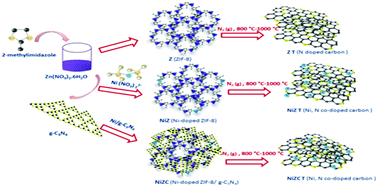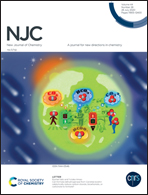Template assisted synthesis of Ni,N co-doped porous carbon from Ni incorporated ZIF-8 frameworks for electrocatalytic oxygen reduction reaction†
Abstract
A heteroatom doped porous carbon electrocatalyst with enhanced oxygen reduction reaction (ORR) performance in alkaline medium was obtained by high temperature treatment of Ni incorporated ZIF-8 frameworks and its composite with g-C3N4 as a supporting matrix template. The morphology and porosity of this heteroatom containing carbon were tuned by varying the Ni : Zn molar ratio in Ni/Zn ZIF-8 and Ni/Zn ZIF-8@g-C3N4 composites. The template aided synthetic strategy using g-C3N4 helped in the controlled decomposition of composites leading to a heteroporous sheet like architecture with increased nitrogen content. The Ni/Zn ZIF-8 sample on heat treatment in the 800–1000 °C temperature range led to the formation of Ni,N co-doped porous carbon (Ni-NPC) with Ni–C active sites. The defective sites induced by nickel carbide along with the distributed N atoms on the carbon surface enabled active O2 adsorption sites. The high surface area, high degree of graphitisation as well as the defects created by well dispersed N and Ni on porous carbon matrices favoured charge separation leading to higher electrochemical ORR activity. The Ni,N co-doped carbon catalyst in alkaline medium exhibited a limiting current density of 5.2 mA cm−2 with a half-wave potential of 0.76 V vs. RHE in 0.1 M KOH. The catalyst also showed improved methanol tolerance and better stability compared to the standard Pt/C catalyst.



 Please wait while we load your content...
Please wait while we load your content...